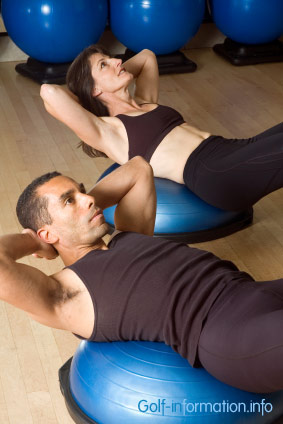
Because golf is a precision game in which the mental approach and strategic decisions play important parts, many players erroneously believe that fitness and muscle training are superfluous.
Nothing could be further from the truth: it does not matter whether you understood mentally how to execute a correct golf swing if your body cannot get you there.
Mobility, flexibility and balance, which are key in a golfer’s game are served by healthy ligaments, tendons and joints which are in turn protected by our muscle structure. Less muscle mass translates into more stress exercised on the ligaments and tendons.
However, this does not mean that just any weight training program will be good to enhance a golfer’s potential. A weight training program that is beneficial to golfers should be especially designed to develop those muscles and body parts that ensure fluidity, balance and support needed to execute repetitive golf movements.
Although golf is considered a “low impact” sport (as compared to running or hockey, for example), the shoulders, wrist and elbow can suffer from impact injuries in certain circumstances. A properly exercised body has a better ability to absorb tension force on the joint.
Also, any stiffness in the shoulders or spine make a fluid and efficient swing impossible. Strengthening the less sollicited support muscles is thus as important (if not more) than training the primary powering muscles.
That is why a weight training program specifically designed for golfers is a must. (See: Ultimate Guide to Weight Training for Golf. See also: weight training for golf). Some fitness programs go even further and include a conditioning and nutrition regimen, see: Core Performance Golf: The Revolutionary Training and Nutrition Program for Success On and Off the Course.
Proper exercising also activates your muscle memory or kinesthetic memory, i.e. it trains your body to perform and repeat a specific appropriate musculoskeletal movement until it becomes a second nature. Conditioned by training the golfer’s muscles and joints will then move in a familiar manner based on memorized sequences (of similar shots made under comparable conditions) without having to think about the mechanics of the mouvement. More about activitating muscle memory in the section “Activate Kinesthetic Memory” in the book Newton on the tee and in the book Get yourself in shape.
Apart form a healthy muscle mass, flexibility and balance are the next aspects to train. Yoga is very popular as an off-course prepartion to golf as it trains both the mind (concentration) as well as the body (flexibility and balance).
See also: Yoga for golfers >>

